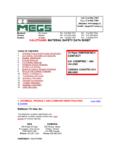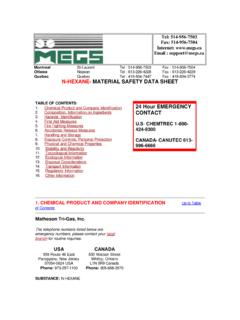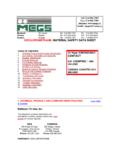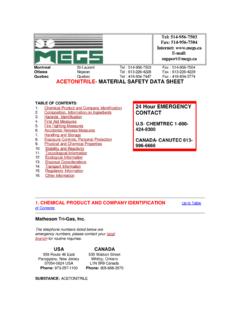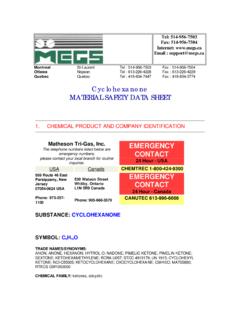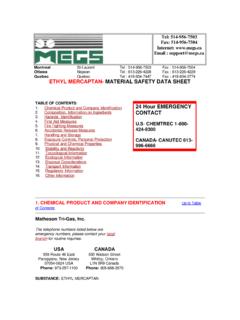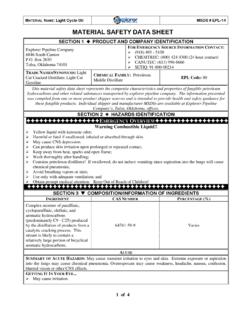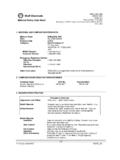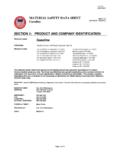Transcription of BENZENE- MATERIAL SAFETY DATA SHEET - MEGS
1 Tel: 514-956-7503 Fax: 514-956-7504 Internet: E-mail: Montreal St-Laurent Tel : 514-956-7503 Fax : 514-956-7504 Ottawa Nepean Tel : 613-226-4228 Fax : 613-226-4229 Quebec Quebec Tel : 418-834-7447 Fax : 418-834-3774 benzene - MATERIAL SAFETY data SHEET TABLE OF CONTENTS: 1. Chemical Product and Company Identification 2. Composition, Information on Ingredients 3. Hazards Identification 4. First Aid Measures 5. Fire Fighting Measures 6. Accidental Release Measures 7. Handling and Storage 8. Exposure Controls, Personal Protection 9. Physical and Chemical Properties 10. Stability and Reactivity 11.
2 Toxicological Information 12. Ecological Information 13. Disposal Considerations 14. Transport Information 15. Regulatory Information 16. Other Information 24 Hour EMERGENCY CONTACT CHEMTREC 1-800-424-9300 CANADA- CANUTEC 613-996-6666 1. CHEMICAL PRODUCT AND COMPANY IDENTIFICATION-----------Up to Table of Contents Matheson Tri-Gas, Inc. The telephone numbers listed below are emergency numbers, please contact your local branch for routine inquiries. USA 959 Route 46 East Parsippany, New Jersey 07054-0624 USA Phone: 973-257-1100 CANADA 530 Watson Street Whitby, Ontario L1N 5R9 Canada Phone: 905-668-3570 SUBSTANCE: benzene SYMBOL: C6H6 TRADE NAMES/SYNONYMS: BENZOL; CYCLOHEXATRIENE; BENZOLE; PHENE; PYROBENZOL; PYROBENZOLE; CARBON OIL; COAL TAR NAPHTHA; PHENYL HYDRIDE; BENZOLENE; BICARBURET OF HYDROGEN; COAL NAPHTHA; MOTOR BENZOL; ANNULENE; (6)ANNULENE; RCRA U019; STCC 4908110; UN 1114; C6H6; MAT02610; RTECS CY1400000 CHEMICAL FAMILY: hydrocarbons, aromatic CREATION DATE: Jan 24 1989 REVISION DATE: Mar 16 1999 2.
3 COMPOSITION, INFORMATION ON INGREDIENTS-----------Up to Table of Contents COMPONENT: benzene CAS NUMBER: 71-43-2 EC NUMBER (EINECS): 200-753-7 PERCENTAGE: >99 COMPONENT: THIOPHENE CAS NUMBER: 110-02-1 EC NUMBER (EINECS): 203-729-4 PERCENTAGE: 3. HAZARDS IDENTIFICATION-----------Up to Table of Contents NFPA RATINGS (SCALE 0-4): HEALTH=3 FIRE=3 REACTIVITY=0 WHMIS CLASSIFICATION: BD2 EC CLASSIFICATION (ASSIGNED): F Highly Flammable T Toxic Carcinogen Category 1 R 11-45-48/23/24/25 EC Classification may be inconsistent with independently-researched data . EMERGENCY OVERVIEW: Color: colorless to yellow Physical Form: liquid Major Health Hazards: respiratory tract irritation, skin irritation, eye irritation, central nervous system depression, cancer hazard (in humans) Physical Hazards: Flammable liquid and vapor.
4 Vapor may cause flash fire. POTENTIAL HEALTH EFFECTS: INHALATION: Short Term Exposure: irritation, ringing in the ears, nausea, vomiting, chest pain, difficulty breathing, irregular heartbeat, headache, drowsiness, symptoms of drunkenness, disorientation, blurred vision, lung congestion, blood disorders, paralysis, convulsions, coma Long Term Exposure: hearing loss, visual disturbances, reproductive effects, brain damage, cancer SKIN CONTACT: Short Term Exposure: irritation, blisters Long Term Exposure: tingling sensation EYE CONTACT: Short Term Exposure: irritation Long Term Exposure: no information on significant adverse effects INGESTION: Short Term Exposure: nausea, vomiting, chest pain, headache, drowsiness, symptoms of drunkenness, disorientation, visual disturbances, lung congestion, paralysis, convulsions, coma Long Term Exposure: impotence, cancer CARCINOGEN STATUS: OSHA: Y NTP: Y IARC: Y 4.
5 FIRST AID MEASURES-----------Up to Table of Contents INHALATION: When safe to enter area, remove from exposure. Use a bag valve mask or similar device to perform artificial respiration (rescue breathing) if needed. Keep warm and at rest. Get medical attention immediately. SKIN CONTACT: Remove contaminated clothing, jewelry, and shoes immediately. Wash with soap or mild detergent and large amounts of water until no evidence of chemical remains (at least 15-20 minutes). Get medical attention, if needed. EYE CONTACT: Wash eyes immediately with large amounts of water or normal saline, occasionally lifting upper and lower lids, until no evidence of chemical remains.
6 Get medical attention immediately. INGESTION: Contact local poison control center or physician immediately. Never make an unconscious person vomit or drink fluids. When vomiting occurs, keep head lower than hips to help prevent aspiration. If person is unconscious, turn head to side. Get medical attention immediately. NOTE TO PHYSICIAN: For inhalation, consider oxygen. For ingestion, consider gastric lavage. 5. FIRE FIGHTING MEASURES-----------Up to Table of Contents FIRE AND EXPLOSION HAZARDS: Severe fire hazard. Moderate explosion hazard. Vapor/air mixtures are explosive. The vapor is heavier than air. Vapors or gases may ignite at distant ignition sources and flash back.
7 Electrostatic discharges may be generated by flow or agitation resulting in ignition or explosion. EXTINGUISHING MEDIA: regular dry chemical, carbon dioxide, water, regular foam Large fires: Use regular foam or flood with fine water spray. FIRE FIGHTING: Move container from fire area if it can be done without risk. Cool containers with water spray until well after the fire is out. Stay away from the ends of tanks. For fires in cargo or storage area: Cool containers with water from unmanned hose holder or monitor nozzles until well after fire is out. If this is impossible then take the following precautions: Keep unnecessary people away, isolate hazard area and deny entry.
8 Let the fire burn. Withdraw immediately in case of rising sound from venting SAFETY device or any discoloration of tanks due to fire. For tank, rail car or tank truck: Evacuation radius: 800 meters (1/2 mile). Water may be ineffective. FLASH POINT: 12 F (-11 C) (CC) LOWER FLAMMABLE LIMIT: UPPER FLAMMABLE LIMIT: AUTOIGNITION: 928 F (498 C) FLAMMABILITY CLASS (OSHA): IB 6. ACCIDENTAL RELEASE MEASURES-----------Up to Table of Contents AIR RELEASE: Reduce vapors with water spray. Stay upwind and keep out of low areas. SOIL RELEASE: Dig holding area such as lagoon, pond or pit for containment. Dike for later disposal. Absorb with sand or other non-combustible MATERIAL .
9 WATER RELEASE: Cover with absorbent sheets, spill-control pads or pillows. Apply detergents, soaps, alcohols or another surface active agent. Collect with absorbent into suitable container. Absorb with activated carbon. Remove trapped MATERIAL with suction hoses. Collect spilled MATERIAL using mechanical equipment. Subject to California Safe Drinking Water and Toxic Enforcement Act of 1986 (Proposition 65). Keep out of water supplies and sewers. OCCUPATIONAL RELEASE: Avoid heat, flames, sparks and other sources of ignition. Stop leak if possible without personal risk. Reduce vapors with water spray. Small spills: Absorb with sand or other non-combustible MATERIAL .
10 Collect spilled MATERIAL in appropriate container for disposal. Large spills: Dike for later disposal. Remove sources of ignition. Keep unnecessary people away, isolate hazard area and deny entry. Reportable Quantity (RQ): Notify Local Emergency Planning Committee and State Emergency Response Commission for release greater than or equal to RQ ( SARA Section 304). If release occurs in the and is reportable under CERCLA Section 103, notify the National Response Center at (800)424-8802 (USA) or (202)426-2675 (USA). 7. HANDLING AND STORAGE-----------Up to Table of Contents Store and handle in accordance with all current regulations and standards.
